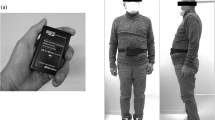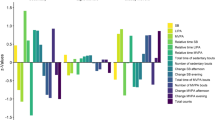Abstract
The objective of this study was to explore the feasibility of using wearable devices to quantitatively measure the daily activity in patients with Parkinson’s disease (PD) and to monitor medication-induced motor fluctuations. In this case-controlled study, we used monitored daily movement function in 21 patients with Parkinson’s disease and 20 healthy volunteers. We analyzed the exercise types and sleep duration in the two groups and evaluated the correlation between daily movement function and age, gender, education, disease duration, Hohn-Yahr stage, UPDRS-II score, UPDRS-III score, and levodopa dose. We also determined the amount of exercise performed by PD patients at 1 h after taking levodopa and at 1 h before the next dose. The type of activity, average speed, and sleep duration in patients were significantly lower in PD patients than in healthy controls (P < 0.05). One hour after taking levodopa, patients were significantly more active than 1 h before the next dose (P < 0.05).Correlation analysis showed that age, gender, education, disease duration, Hohn-Yahr stage, UPDRS-II and UPDRS-III scores, and dosage of levodopa do not correlate with the daily movement function (P > 0.05) in patients with Parkinson’s disease. In the control group, age and education were associated with daily movement function (P < 0.05), while gender was unrelated (P > 0.05). Continuous monitoring of daily activity may be useful to reveal medication-induced motor fluctuations in Parkinson’s disease. The daily movement function may depend on age and education, but not on other parameters.


Similar content being viewed by others
References
Qiang G, Chengqi H (2008) Evaluation of motor function and exercise therapy in patients with Parkinson's disease. Chinese Journalof RehabilitationMedicine 23(5):473–476
Crizzle AM (2006) New house IJ. Is physical exercise beneficial for persons with Parkinson’s disease? Clin J Sport Med 16(5):422–425
Fahn S (2005) The Parkinson Study Group. Does levodopa slow or hasten the rate of progression of Parkinson’s disease? J Neurol 252(4):37–42
Lang AE, Eberly S, Goetz CG et al (2013) Movement disorder society unified Parkinson disease rating scale experiences in daily living: longitudinal changes and correlation with other assessments. Mov Disord 28(14):1980–1986
Weintraub D, Moberg PJ, Duda JE et al (2004) Effect of psychiatric and other nonmotor symptoms on disability in Parkinson’s disease. J Am Geriatr Soc 52:784–788
Postuma RB, Lang AE, Massicotte-Marquez J, Montplaisir J (2006) Potential early markers of Parkinson disease in idiopathic REM sleep behavior disorder. Neurology 66(6):845–851
Liang S, Biao C (2012) Application value of quantitative motion detection in early diagnosis and evaluation of Parkinson’s disease. Chinese Journal of Nervous and Mental Diseases 38(7):416–448
Xiao ZG, Menon C (2014) Towards the development of a wearable feedback system for monitoring the activities of the upper-extremities. J Neuroeng Rehabil 11:2–13
Strommen AM, Christensen T, Jensen K (2014) Quantitative measurement of physical activity in acute ischemic stroke and transient ischemic attack. Stroke 45(12):3649–3655
Gibb WRG, Lees A (1988) The relevance of the Lewy body to the pathogenesis of idiopathic Parkinson’s disease. J Neurol Neurosurg Psychiatry 51:745–752
Mancini M, El-Gohary M, Pearson S et al (2015) Continuous monitoring of turning in Parkinson’s disease: rehabilitation potential. Neuro Rehabilitation 37(1):3–10
Espay AJ, Baram Y, Dwivedi AK et al (2010) At-home training with closed-loop augmented-reality cueing device for improving gait in patients with Parkinson disease. J Rehabil Res Dev 47(6):573–581
Jenner P (2013) Wearing off, dyskinesia, and the use of continuous drug delivery in Parkinson’s disease. Neurol Clin 31:17–35
Alcalay RN, Caccappolo E, Mejia-Santana H et al (2014) Cognitive and motor function in long-duration PARKIN-associated Parkinson disease. JAMA Neurol 71(1):62–67
Roberto Cilia et al. (2013) Parkinson’s disease progression highly variable. Medscape
Weaver FM, Follett K, Stern M et al (2009) Bilateral deep brain stimulation vs best medical therapy for patients with advanced Parkinson disease: a randomized controlled trial. JAMA 301:63–73
Diaz AP, Freitas FC, de Oliveira Thais ME et al (2016) Variables associated with physical health-related quality of life in Parkinson’s disease patients presenting for deep brain stimulation. Neurol Sci 37(11):1831–1837
Goodwin VA, Richards SH, Henley W et al (2011) An exercise intervention to prevent falls in people with Parkinson’s disease: a pragmatic randomised controlled trial. J Neurol Neurosurg Psychiatry 82:1232–1238
Tomlinson CL, Patel S, Meek C et al (2013) Physiotherapy versus placebo or no intervention in Parkinson’s disease. Cochrane Database Syst Rev 9:CD002817
Tzallas AT, Tsipouras MG, Rigas G et al (2014) PERFORM: a system for monitoring, assessment and management of patients with Parkinson’s disease. Sensors 14(11):21329–21357
Comella CL (2002) Daytime sleepiness, agonist therapy, and driving in Parkinson’s disease. JAMA 287(4):509–511
Li K, Li SH, Su W, Chen HB (2017) Diagnostic accuracy of REM sleep behaviour disorder screening questionnaire: a meta-analysis. Neurol Sci 38(6):1039–1046
Bugalho P, Viana-Baptista M (2013) REM sleep behavior disorder and motor dysfunction in Parkinson's disease—a longitudinal study. Parkinsonism Relat Disord 19(12):1084–1087
Carbonaro N, Dalle MG, Lorussi F et al (2014) Exploiting wearable goniometer technology for motion sensing gloves. IEEE J Biomed Health. Inform 18(6):1788–1795
Lemmens RJ, Janssen-Potten YJ, Timmermans AA et al (2015) Recognizing complex upper extremity activities using body worn sensors. PLoS One 10(3):e0118642
Friedman N, Rowe JB, Reinkensmeyer DJ et al (2014) The manumeter: a wearable device for monitoring daily use of the wrist and fingers. IEEE J Biomed Health Inform 18(6):1804–1812
Rowe J, Friedman N, Bachman M et al (2013) The manumeter: a non-obtrusive wearable device for monitoring spontaneous use of the wrist and fingers. IEEE Int Conf Rehabil Robot 2013:6650397
Acknowledgements
This work was supported by the Fujian Provincial Health and Family Planning Commission Youth Research Project (2015-1-32), Fujian Provincial Science and Technology Guiding Project (2017Y0041), National Natural Science Foundation of China (81271414), and Key Clinical Specialty Discipline Construction Program of Fujian and Nation, P.R.C.
Author information
Authors and Affiliations
Corresponding author
Ethics declarations
Conflict of interest
The authors declare that they have no conflict of interest regarding the publication of this paper.
Ethics statement
Study participants voluntarily agreed to participate in the study and provided written informed consent prior to enrollment. The study was approved by the Ethics Committee of Union Hospital Affiliated to Fujian Medical University. All procedures performed in studies involving human participants were in accordance with the ethical standards of the institutional and/or national research committee and with the 1964 Helsinki declaration and its later amendments or comparable ethical standards.
Additional information
Guoen Cai and Yujie Huang are co-first authors.
Rights and permissions
About this article
Cite this article
Cai, G., Huang, Y., Luo, S. et al. Continuous quantitative monitoring of physical activity in Parkinson’s disease patients by using wearable devices: a case-control study. Neurol Sci 38, 1657–1663 (2017). https://doi.org/10.1007/s10072-017-3050-2
Received:
Accepted:
Published:
Issue Date:
DOI: https://doi.org/10.1007/s10072-017-3050-2




